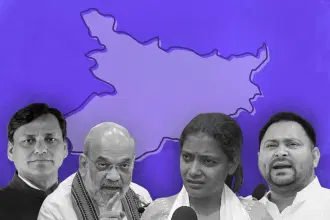Culture
Systematic Secularisation: How Congress Hijacked Mysuru Dasara, Diluted Its Hindu Core, And Turned It Into Political Theatre
Deviyani G
Sep 22, 2025, 11:48 AM | Updated Oct 18, 2025, 10:31 PM IST
Save & read from anywhere!
Bookmark stories for easy access on any device or the Swarajya app.


When Karnataka Chief Minister Siddaramaiah invited Booker Prize winner Banu Mushtaq to inaugurate this year's Mysuru Dasara, despite her controversial remarks about Goddess Bhuvaneshwari, the decision led to a fierce outrage among Hindu devotees. Yet for those familiar with the deeper currents of history, this controversy represents merely the latest salvo in a decades-long campaign by the Congress party to systematically strip one of India's most sacred festivals of its Hindu identity.
Siddaramaiah's defence laid bare the ideological foundation driving this transformation: "Dussehra is a non-religious festival... Everyone celebrates the Dasara festival... It is a festival for Hindus, Christians, Buddhists, Jains. When the Maharaja was not in power, even Hyder Ali and Tipu Sultan celebrated Dussehra. This is a non-religious festival."
This reimagining of Dasara's essence has compelled R Raja Chandra Urs, husband of Maharajkumari Indrakshi Devi (daughter of the late Jayachamraja Wadiyar, Maharaja of Mysuru), to break his silence. In an exclusive conversation with Swarajya, he exposes how the Congress party has orchestrated a calculated secularisation campaign that commenced immediately after Independence and persists to this day.
The Ancient Roots Congress Seeks to Erase
"Dasara stands as fundamentally a Hindu festival whose sacred origins stretch back to the Treta Yuga itself," Urs declares with unwavering conviction. "It transcends the mere innovations of the Vijayanagara dynasty or the Wadiyars who followed. The festival embodies something far more ancient and profound."
The festival's sacred elements, the worship of pattada aane (royal elephant), pattada kudure (royal horse), and pattada hasu (royal cow), represent, as he articulates, "profound symbols of Indra's sabha, the divine assembly presided over by the king of the gods himself."
Yet Siddaramaiah's secular narrative obscures these spiritual foundations. "While contemporary society witnesses people from diverse religious backgrounds seeking to participate in the celebration," Urs acknowledges, "such participation cannot transform it into a secular festival. The festival's core essence, its spiritual roots, its sacred origins, and its time-honoured traditions have always remained Hindu, centred firmly around the Hindu pantheon of gods."
Drawing a pointed analogy, he argues: "Consider this parallel. Merely because political leaders of all castes and religious backgrounds attend iftar parties today, does that render Ramadan a secular festival? The logic proves equally flawed when applied to Dasara."
The Sacred Journey to Banni Tree: Lost in Translation
The most egregious distortion, according to Urs, involves the festival's spiritual centrepiece, the sacred journey to Bannimatapa. "When people observe Dasara in contemporary times, they focus exclusively on the superficial spectacle," he laments. "They witness the grandeur, the king, the elephants, the magnificent procession, and only these visual elements linger in their memory. Precious few comprehend the deeper spiritual purpose of the journey to Bannimatapa: the worship of the sacred Banni tree, revered as a powerful symbol of shakti."
Even the festival's nomenclature has suffered corruption through widespread ignorance. "Consider the term 'Jumbo Savari.' Most people associate it with elephants due to the word 'jumbo'," he explains. "However, the original term was 'Jambi Savari,' derived from 'Jambi,' another designation for the Banni tree. The procession constituted essentially a sacred journey, the Jambi Savari, where the ruler would travel to worship this divine tree. The entire purpose remained spiritual worship, never public exhibition."
"The elephants served merely as modes of transportation," Urs clarifies. "Upon the elephant sat the golden howdah, within which the Raja would be seated. The howdah represented simply an extension of his personal regalia, nothing more."
Historical documentation substantiates this interpretation. "Should one examine the earliest texts describing Dasara from Ranadheera Kantirava's era, specifically the Kanteerava Narasaraja Vijayam by the poet Govinda Vaidya, we discover that the king originally travelled on horseback, not by elephant. This demonstrates clearly that the mode of transportation evolved over time from horse to elephant, while the spiritual essence remained constant and unchanging."
The Invented "Inauguration": Manufacturing Secular Rituals
The very concept of a formal inauguration, Urs reveals, represents a Congress innovation rather than traditional practice. "Prior to 1969, no such concept as a formal 'inauguration' of Dasara existed," he states. "The festival would commence with the sacred assembling of the throne, a ritual occurring before Amavasya. Notably, this throne saw exclusive use during Dasara, underscoring its sacred significance."
The authentic celebration followed time-honoured spiritual protocols. "On the morning of Navaratri's first day, the King and Queen would partake in yenne sanna, followed by the sacred tying of the Kankana cloth around their hands. This ritual elevated them above all worldly obstacles for the subsequent nine days, enabling them to fulfil their religious obligations without impediment."
"The morning would then witness the formal ascending of the throne, a deeply private, sacred affair. Only in the evening would the Durbar be conducted."
Instead, Congress governments manufactured new rituals. "This spectacle of the Chief Minister ascending Chamundi Hill to offer floral tributes to the goddess, accompanied by whichever Chief Guest they select that year, regardless of that person's genuine respect or devotion to the deity, represents purely the invention of pseudo-secular political entities. It embodies no authentic traditional element of Dasara whatsoever."
The contradiction strikes at the heart of secular hypocrisy: "One must ask, why does a supposedly secular government perform religious poojas at all?"
The Hijacked Howdah
Perhaps the most shocking innovation involves replacing the Maharaja with the goddess herself in the golden howdah. "In current practice, the idol of Goddess Chamundi occupies the golden howdah," Urs explains. "This manipulation was implemented by the government after 1975."
The historical precedent tells a different story. "The author Navaratna Ram Rao, who served as a senior administrator and maintained close friendship with Rajaji, documented that during his tenure as commissioner, people even within their private celebrations would conduct processions using bullock carts carrying the Maharaja's photograph, not the goddess herself."
This substitution violates both tradition and spiritual logic. "Goddess Chamundi receives worship throughout the year, with special poojas conducted on auspicious occasions. During Dasara specifically, the goddess receives honour during the Rathostava procession, which occurs toward the festival's conclusion. To replace the Maharaja's traditional presence during his sacred journey as the royal family's scion to Banimatapa for worship, substituting instead the goddess Chamundeshwari herself, makes no spiritual or traditional sense."
Historical Resistance: When People Rejected Secular Impositions
Even in earlier periods, attempts to secularise the festival faced fierce popular resistance. Urs recalls a revealing incident from the 1930s: "When Sir Mirza Ismail served as Diwan, the then Maharaja Krishnaraja Wadiyar attempted to include him prominently in the procession. The people of Mysore responded with such outrage at witnessing the Diwan seated in such a position of prominence that during the procession's return journey, they actually attacked the elephants. Even our deeply revered Maharaja found himself compelled to flee for his safety, such was the intensity of popular sentiment."
This resistance persisted into the modern era. "Even during the post-1975 Dasara celebrations, after the rituals had already undergone significant secularisation, we witnessed similar incidents. When Gundu Rao served as Chief Minister, he could not perform the puja to the Chamundeshwari idol during Dasara due to a close relative's death. Governor Kurshed Alam Khan was designated to take his place. At that time, Baskar, the Commissioner of Police of Mysore, reportedly ensured that the governor could not reach the palace on schedule. He was subsequently suspended and transferred elsewhere."
The Temple Takeover: Seizing Sacred Assets
The secularisation campaign extends to outright property seizure. "They have established what they term the 'Chamundi Hill Development Authority' in 2024, and just before this year's Dasara, reports emerged that the temple's sacred custody, literally the lock and key, has been formally transferred to this body's secretary. This occurred despite the temple being clearly listed as private property of the Wadiyars in official records from 1950," Urs reveals. "The government has essentially hijacked both the festival and the temple itself."
The protocols being imposed violate temple tradition itself. "I challenge anyone to name another Indian temple where such practices exist. In every traditional Indian temple, there typically exists a fixed stone idol in a permanent location, accompanied by the Utsava Murti which is carried in processions. At Chamundi Hill, processions occur at least three times daily, with puja offered to the Utsava Murti during each occasion. It is not as though the Utsava Murthi remains locked away throughout the year, only emerging during festivals. These protocols the government seeks to establish possess no basis in authentic tradition or Puranic scholarship."
The transformation becomes evident when examining Congress's approach to festival leadership. Early resistance from within the party itself reveals the artificial nature of current practices. "I have examined archives in Delhi which reveal that when Kengal Hanumanthaiah became Chief Minister, he actually questioned why he should participate in the procession at all. In those days, the Chief Minister would traditionally lead on horseback before the main procession. Hanumanthaiah regarded it as the Maharaja's private religious function. The Maharaja responded with characteristic grace, clarifying that he had never commanded anyone's attendance, participation remained entirely at individual discretion."
The Maharaja's own understanding of the festival's spiritual essence contrasted sharply with political opportunism. When offered alternative grand arrangements during his tenure as Governor of Madras, including processions on Mount Road, "The Maharaja declined respectfully, stating that his Kuladevi resided in Mysore, his sacred puja room was in Mysore, and that the procession represented merely a small portion of the larger celebration and worship involved. He had numerous other sacred commitments that the gods had commanded him to fulfil, and these could not be replicated elsewhere."
A Timeline of Systematic Secularisation
1980: The Congress government led by Chief Minister R. Gundu Rao formalised state control over Mysuru Dasara by appointing a divisional-level committee, chaired by the Divisional Commissioner, to plan and execute the celebrations. This marked a clear administrative shift away from the festival's earlier royal-led tradition.
2001: Chief Minister S. M. Krishna (Congress) became the official inaugurator of the Jamboo Savari/Mysuru Dasara procession on 26 October. Instead of leaving the role to traditional custodians, the Congress CM performed rituals such as offering floral tributes to Goddess Chamundeshwari's idol in the golden howdah atop elephant Balarama. This diminished the Mysuru Maharaja's traditional significance.
2005: The Congress government led by Chief Minister Dharam Singh organised Mysore Dussehra, transforming the festival into a government spectacle rather than a community celebration. Dharam Singh himself performed royal rituals such as worshipping the Nandi flag and showering flowers on the idol of Goddess Chamundeshwari in a golden howdah mounted on Balarama elephant.
2013: Under the Siddaramaiah-led Congress government, poet Dr Chandrashekar Kambar was invited to inaugurate the Mysore Dasara at Chamundi Hill alongside the Chief Minister and district officials. The event took a political turn when Kambar publicly declared that "the lives of Kannadigas are miserable under the rule of unstable governments," directly linking the festival to the ruling party. This led to Mysore Dussehra being used as a platform to advance Congress's political agenda under the guise of a cultural festival.
2025: On 22 August, the Congress-led Karnataka government invited Kannada writer Banu Mushtaq to inaugurate the Dasara festival at Chamundi Hills in Mysuru on 22 September. Karnataka CM Siddaramaiah defended the decision on 31 August, describing the event as a "secular" and "cultural" festival for all communities. Member of Mysuru's erstwhile royal family and MP Yaduveer Krishnadatta Chamaraja Wadiyar's mother, Pramoda Devi Wadiyar, expressed dismay over the government's handling of the Mysuru Dasara, saying politics had entered the Chamundeshwari Temple.
Contrasts That Expose Hypocrisy
The selective nature of this secularisation becomes evident when contrasted with how other religious festivals receive state accommodation. "Consider the contrast with how the state accommodates the Painkuni festival celebrated at the renowned Sree Padmanabha Swamy Temple," Urs points out. "For several hours on a specific day in April, the Thiruvananthapuram International Airport voluntarily shuts down its operations to accommodate a procession led by the head of the Travancore Royal family. Devotees pull ornate wooden chariots bearing temple deities across a two-kilometre stretch of the airport runway, with elephants accompanying this magnificent procession."
This differential treatment reveals the targeting of Hindu festivals specifically for secular transformation while other religious traditions maintain their authentic character with full state support.
"Today, the royals must instead visit the Banni tree located within the precincts of the Bhuvaneswari temple inside the Mysore palace complex," Urs concludes. "Unfortunately, even the royals' ownership of the palace itself faces increasing threats from government interference."
The secularisation campaign has thus evolved from ritual manipulation to complete institutional capture, threatening not just the festival's spiritual character but the very foundations of its historical custodianship.
"The only documented history we possess of Dasara being celebrated by royalty with such scale and grandeur traces first to the Vijayanagara Empire and subsequently to the Wadiyars of Mysore," Urs emphasises. "Given the profound significance of this celebration, it proves deeply troubling to witness repeated interference and systematic distortion by the state apparatus."
Siddaramaiah's defence of secularisation reveals a deeper ideological project: the erasure of Hindu identity from public celebrations, replacing authentic spiritual traditions with politically convenient narratives that serve electoral calculations rather than devotional purposes.
The question confronting Karnataka's Hindu devotees is whether they will continue accepting this manufactured secularism or demand restoration of Dasara's authentic spiritual character.
The festival that once embodied the divine journey to the Banni tree, a pilgrimage of profound spiritual significance, has been reduced to a government-managed spectacle where controversy-courting authors inaugurate Hindu celebrations while politicians perform religious rituals they claim are secular.
This transformation from Jambi Savari to "Jumbo Savari," from sacred pilgrimage to political theatre, represents perhaps the most successful secularisation campaign in modern India. The question remains whether devotees will continue to accept this distortion or reclaim their festival's authentic Hindu identity.





